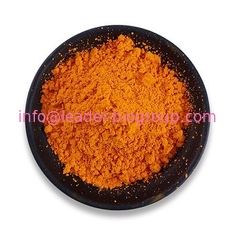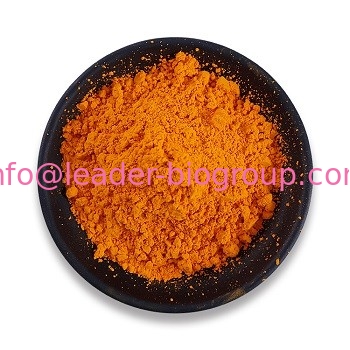
China Factory Supply Vitamin B2/Riboflavin CAS 83-88-5 Inquiry: info@leader-biogroup.com
-
Purity99.9%
-
UseChemical Raw Materials
-
OriginChina
-
Package25KG/Drum
-
ManufacturerXI'AN LEADER BIOCHEMICAL ENGINEERING CO.,LTD
-
AppearanceYellow To Orange Powder
-
Place of OriginCHINA
-
Brand Nameinfo@leader-biogroup.com
-
CertificationISO,GMP,SGS,HALA,KOSER,HACCP
-
Model NumberLD
-
Minimum Order Quantity25KG
-
PriceNegotiate Depend on order quantity
-
Packaging Details25KG/Drum
-
Delivery Time2-3 working days
-
Payment TermsWestern Union, MoneyGram, T/T, L/C
-
Supply Ability10MTS/Month
China Factory Supply Vitamin B2/Riboflavin CAS 83-88-5 Inquiry: info@leader-biogroup.com
LEADER BIOCHEMICAL GROUP
XI'AN LEADER BIOCHEMICAL ENGINEERING CO.,LTD
Inquiry: info@leader-biogroup.com
Hot Line: +86-029-68895030
+86-029-68569962
Fax : +86-029-68569961
| Product Name: | Riboflavin |
| Synonyms: | vitasanb2;xy)-;E 101;Riboflavin (1.07609);Riboflavin Vitamin B2;Vitamin B2 (Riboflavine);RIBOFLAVIN DC GRADE;RIBOFLAVIN USP (VITAMIN B-2) |
| CAS: | 83-88-5 |
| MF: | C17H20N4O6 |
| MW: | 376.36 |
| EINECS: | 201-507-1 |
| Product Categories: | Chiral Reagents;Heterocycles;PHARMACEUTICALS;Intermediates & Fine Chemicals;API;FLAVAXIN;Vitamins and derivatives;Vitamin Ingredients;Miscellaneous Compounds;Vitamin series;Isolabel;vitamin;Inhibitor of poly(ethylene glycol) oxidation.;Inhibitors;Miscellaneous Natural Products;Biochemistry;Vitamins;Nutritional Supplements |
| Mol File: | 83-88-5.mol |
| Riboflavin Chemical Properties |
| Melting point | 290 °C (dec.)(lit.) |
| alpha | -135 º (c=5, 0.05 M NaOH) |
| Boiling point | 504.93°C (rough estimate) |
| density | 1.2112 (rough estimate) |
| refractive index | -135 ° (C=0.5, JP Method) |
| Fp | 9℃ |
| storage temp. | 2-8°C |
| solubility | Very slightly soluble in water, practically insoluble in ethanol (96 per cent). Solutions deteriorate on exposure to light, especially in the presence of alkali. It shows polymorphism (5.9). |
| pka | 1.7(at 25℃) |
| form | Powder |
| color | Yellow to orange |
| Odor | Slight odour |
| PH | 5.5-7.2 (0.07g/l, H2O, 20°C) |
| PH Range | 6 |
| Water Solubility | 0.07 g/L (20 ºC) |
| Sensitive | Light Sensitive |
| Merck | 14,8200 |
| BRN | 97825 |
| Stability: | Stable, but light-sensitive. Incompatible with strong oxidizing agents, reducing agents, bases, calcium, metallic salts. May be moisture sensitive. |
| InChIKey | AUNGANRZJHBGPY-SCRDCRAPSA-N |
| CAS DataBase Reference | 83-88-5(CAS DataBase Reference) |
| NIST Chemistry Reference | Riboflavine(83-88-5) |
| EPA Substance Registry System | Riboflavin (83-88-5) |
| Safety Information |
| Hazard Codes | F,T |
| Risk Statements | 11-23/24/25-39/23/24/25 |
| Safety Statements | 24/25-45-36/37-16 |
| RIDADR | UN1230 - class 3 - PG 2 - Methanol, solution |
| WGK Germany | 1 |
| RTECS | VJ1400000 |
| F | 8-10-21 |
| TSCA | Yes |
| HS Code | 29362300 |
| Hazardous Substances Data | 83-88-5(Hazardous Substances Data) |
| Toxicity | LD50 in rats (g/kg): >10 orally, 5.0 s.c., 0.56 i.p. (Unna, Greslin) |
| Riboflavin Usage And Synthesis |
| Description | A water-soluble B fraction was found in the 1920s to contain a yellow, fluorescent growth factor called riboflavin in England and vitamin G in the United States. In the early 1930s, several groups found the coenzyme forms of riboflavin 50-phosphate (flavin mononucleotide) and the further conjugate with adenylic acid (flavin adenine dinucleotide). |
| Chemical Properties | VITAMIN B2 (Riboflavin). Some earlier designations for this substance included vitamin G, lactoflavin, hepatoflavin, ovoflavin, verdoflavin. The chemical name is 6,7-dimethyl-9-d-l’ribityl isolloxazine. Riboflavin is a complex pigment with a green fluorescence. |
| Chemical Properties | Yellow to orange/yellow crystalline powd |
| Physical properties | Riboflavin is moderately soluble in water (10–13 mg/dl) and ethanol but insoluble in r, chloroform, and . It is soluble but unstable under alkaline conditions. The catalytic functions of riboflavin are carried out primarily at positions N-1, N-5, and C-4 of the isoalloxazine nucleus. In addition, the methyl group at C-8 participates in covalent bonding with enzyme proteins. The flavin coenzymes are highly versatile redox cofactors because they can participate in either one- or two electron redox reactions Riboflavin antagonists include analogs of the isoalloxazine ring (e.g., diethylri boflavin, dichlororiboflavin) and the ribityl side chain (e.g., d-araboflavin, d-galactoflavin, 7-ethylriboflavin). |
| Originator | Hyflavin ,Endo,US,1948 |
| Uses | Vitamin B2 (riboflavin) is produced by yeast from glucose, urea, and mineral salts in an aerobic fermentation. |
| Uses | Nutritional factor found in milk, eggs, malted barley, liver, kidney, heart, leafy vegetables. Richest natural source is yeast. Minute amounts present in all plant and animal cells. Vitamin (enzyme cofactor). |
| Uses | Vitamin B2; Vitamin cofactor; LD50(rat) 560 mg/kg ip |
| Uses | riboflavin (Vitamin B2) is used in skin care preparations as an emollient. It can be found in sun care products as a suntan enhancer. Medicinally, it is used for the treatment of skin lesions. |
| Uses | Riboflavin is the water-soluble vitamin b2 required for healthy skin and the building and maintaining of body tissues. it is a yellow to orange-yellow crystalline powder. it acts as a coenzyme and carrier of hydrogen. it is stable to heat but may dissolve and be lost in cooking water. it is relatively stable to storage. sources include leafy vegetables, cheese, eggs, and milk. |
| Definition | ChEBI: D-Ribitol in which the hydroxy group at position 5 is substituted by a 7,8-dimethyl-2,4-dioxo-3,4-dihydrobenzo[g]pteridin-10(2H)-yl moiety. It is a nutritional factor found in milk, eggs, malted barley, liver, kidney, heart, and leafy vege ables, but the richest natural source is yeast. The free form occurs only in the retina of the eye, in whey, and in urine; its principal forms in tissues and cells are as flavin mononucleotide and flavin-adenine dinucleotide. |
| Manufacturing Process | 100 g of riboflavin and 3 of potassium carbonate are suspended in 500 cc of the aqueous formaldehyde solution and the mixture is stirred at 30°C for 8 hours. At the end of this period, 5 cc of glacial acetic acid and 1 liter of methanol are added, with stirring. The solution is freed from undissolved material by filtration and the clear solution is poured slowly at about 20°C to 22°C with vigorous stirring into 8 liters of anhydrous . The resultant precipitate is filtered off, washed repeatedly with anhydrous and with r, and then dried at room temperature and with vacuum. The resultant dried powder is dissolved in hot water at 95°C to give an aqueous solution of 20% by weight. This solution is kept in the dark at room temperature for 3 to 4 weeks, after which time a large amount of material crystallizes out of the solution. This crystallized material is removed by filtration and recrystallized from hot water. A small amount of dark red insoluble material is filtered from the hot solution. This recrystallization step is repeated four times. The resultant end product is monomethylol riboflavin, which crystallized in small orange clusters. It has a melting point of 232°C to 234°C with decomposition, and it becomes dark when heated above 225°C. |
| Brand name | Flavaxin (Sterling Winthrop). |
| Therapeutic Function | Enzyme cofactor vitamin source |
| General Description | The conflicting results were eventually found to be due,in part, to deficiencies in study animals not just of vitamin B2,but also vitamin B3 (niacin), the cause of human forms of pellagra,and/or vitamin B6 (pyridoxine), another cause of dermatitis.Likewise, treatments with vitamin B2 were inconsistentbecause the early sources of this vitamin contained otherB vitamins. Vitamin B2 was eventually isolated from eggwhites in 1933 and produced synthetically in 1935. Thename riboflavine was officially accepted in 1960; althoughthe term was in common use before then. In 1966, IUPACchanged it to riboflavin, which is in common use today.Riboflavin is synthesized by all green plants and by mostbacteria and fungi. Therefore, riboflavin is found, at least insmall amounts, in most foods. Foods that are naturally highin riboflavin include milk and other dairy products, meat,eggs, fatty fish, and dark green vegetables. Chemically, riboflavin is an N-glycoside of flavin, alsoknown as lumichrome, and the sugar, ribitol .Flavin is derived from the Latin word flavus for “yellow”because of the yellow color of its crystals and yellow fluorescenceunder UV light. Riboflavin is heat stable but easilydegraded by light. Its systematic names are 7,8-dimethyl-10-ribitylisoalloxazine and 7,8-dimethyl-10-(D-ribo-2,3,4,5-tetrahydroxy)isoalloxazine. |
| Biochem/physiol Actions | Riboflavin serves as a precursor for the active enzyme cofactors riboflavin 5′-monophosphate (also called flavin mononucleotide or FMN) and flavin adenine dinucleotide (FAD). Riboflavin deficiency in the diet results in a well-defined syndrome known as ariboflavinosis, Riboflavin exhibits protective effects against tumor development and cardiovascular disease. Its deficiency often affects metabolism involving redox reactions. Riboflavin is found essential for iron absorption, gastrointestinal development, neurogenesis, corneal vascularization and corneal opacity. |
| Clinical Use | Severe riboflavin deficiency is known as ariboflavinosis, andtreatment or prevention of this condition is the only provenuse of riboflavin. Ariboflavinosis is most commonly associatedwith multiple vitamin deficiency as a result of alcoholismin developed countries. Because of the large numberof enzymes requiring riboflavin as a coenzyme, deficienciescan lead to a wide range of abnormalities. In adults seborrheicdermatitis, photophobia, peripheral neuropathy, anemia, andoropharyngeal changes including angular stomatitis, glossitis,and cheilosis, are often the first signs of riboflavin deficiency.In children, cessation of growth can also occur. As the deficiencyprogresses, more severe pathologies develop untildeath ensues. Riboflavin deficiency may also produce teratogeniceffects and alter iron handling leading to anemia. |
| Safety Profile | Poison by intravenous route. Moderately toxic by intraperitoneal and subcutaneous routes. Mutation data reported. When heated to decomposition it emits toxic fumes of NOx. |
| Environmental Fate | Physicochemical Properties Riboflavin has the appearance of a yellow to orange amorphous solid and imparts an orange color to the B vitamin tablets. Riboflavin has a melting point of 290°C, a density of 1.65, and a refractive index of 135°. The pKa is 9.888 and log P is 0.095. Riboflavin has solubility in water of 0.1 g l-1. Exposure Routes and Pathways The route of exposure is oral. Dietary sources of riboflavin and its coenzymes include broccoli, spinach, asparagus, enriched flour, yeast, eggs, milk, cheese, mackerel, trout, poultry, liver, and kidneys. Toxicokinetics Riboflavin, which is only moderately water soluble, is absorbed from the gastrointestinal tract but is limited to about 27 mg at any one time from an oral dose given to an adult. Hence, mega doses would not be expected to increase significantly the total amount absorbed. It is hepatically metabolized, protein bound, and widely distributed to tissue; however, little is stored in the liver, spleen, heart, and kidneys. Riboflavin is excreted renally as metabolites, which have been oxidatively cleaved in the ribityl side chain and converted to hydroxymethyls in the ring methyl functions. Riboflavin in excess of daily body needs is excreted unchanged in the urine. Riboflavin exhibits biphasic pharmacokinetics with initial and terminal half-lives of 1.4 and 14 h, respectively. |
| Properties and Applications | yellow |
